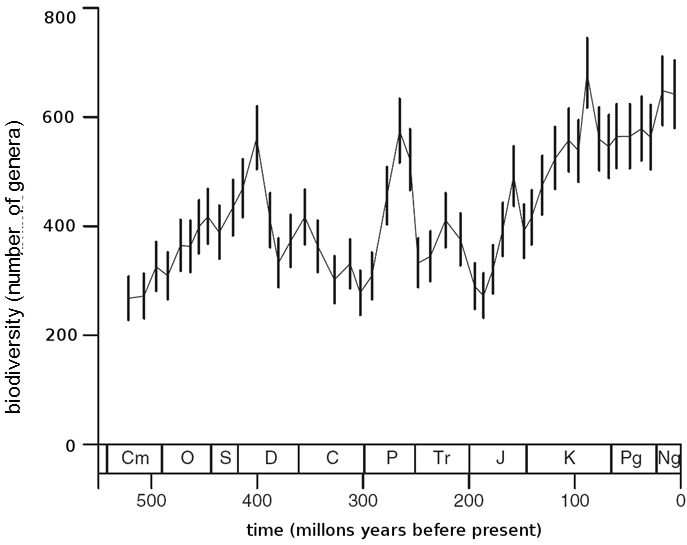I.5 A typical characteristic of organisms is their mutual diversity and the high biodiversity of the biosphere as a whole
The mutual diversity of living systems is another important property. In contrast to complexity and usefulness, this is not an individual characteristic, i.e. a property of individual organisms, but a collective property, i.e. a property of the community of organisms forming the biosphere. The increase in biodiversity, i.e. increase in the number of species of organisms and the diversity of various forms of life (the aspect of diversity denoted by some authors by the term disparity) is far from a monotonous trend. In the history of the development of life, there were periods of mass extinction when, probably as a consequence of drastic changes in external conditions, the number of species was, at the very least, catastrophically reduced to a fraction of the original value (see XXII.5.3.1). However, after the end of the period of mass extinction, other species gradually filled the empty niches so that, in the long term, overall biodiversity gradually increased (Fig. I.11).
A number of mechanisms are responsible for the increase in biodiversity. The numbers of species increase as a consequence of speciation and the differences between species increase through genetic drift, natural selection, species selection and various types of evolutionary drive. Although these mechanisms act constantly, it is far from clear whether the trend towards an increase in biodiversity is constant. As the biodiversity increases fastest right after a period of mass extinction (Courtillot & Gaudemer 1996), it is possible that there are auto-regulating processes in nature that limit the number of species that can exist simultaneously in a given environment (see XXII.7). The gradual increase in biodiversity could be a result of the joint action of forces and processes increasing the diversity of organisms and the processes acting in the opposite direction. However, it cannot be excluded that the increase in biodiversity that occurred in the course of evolution to date could be a manifestation of a passive trend that would be partly a result of the wall effect (biodiversity was zero at the instant when life emerged) and partly a result of the second law of thermodynamics – a natural increase in entropy and thus diversity in a closed system.

Fig. I.11 Increase in biodiversity during the Phanerozoic. The graph shows the gradual increase in biodiversity, specifically the number of living genera of hard-shelled marine animals. In periods of mass extinction, the overall increasing trend is temporarily reversed. According to Alroye et al. (2008).
